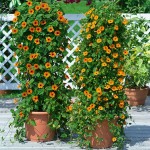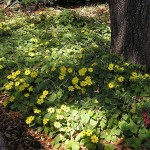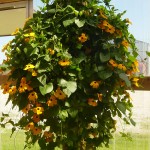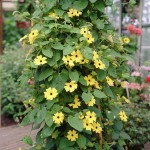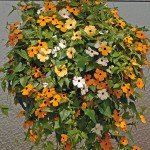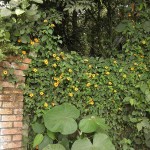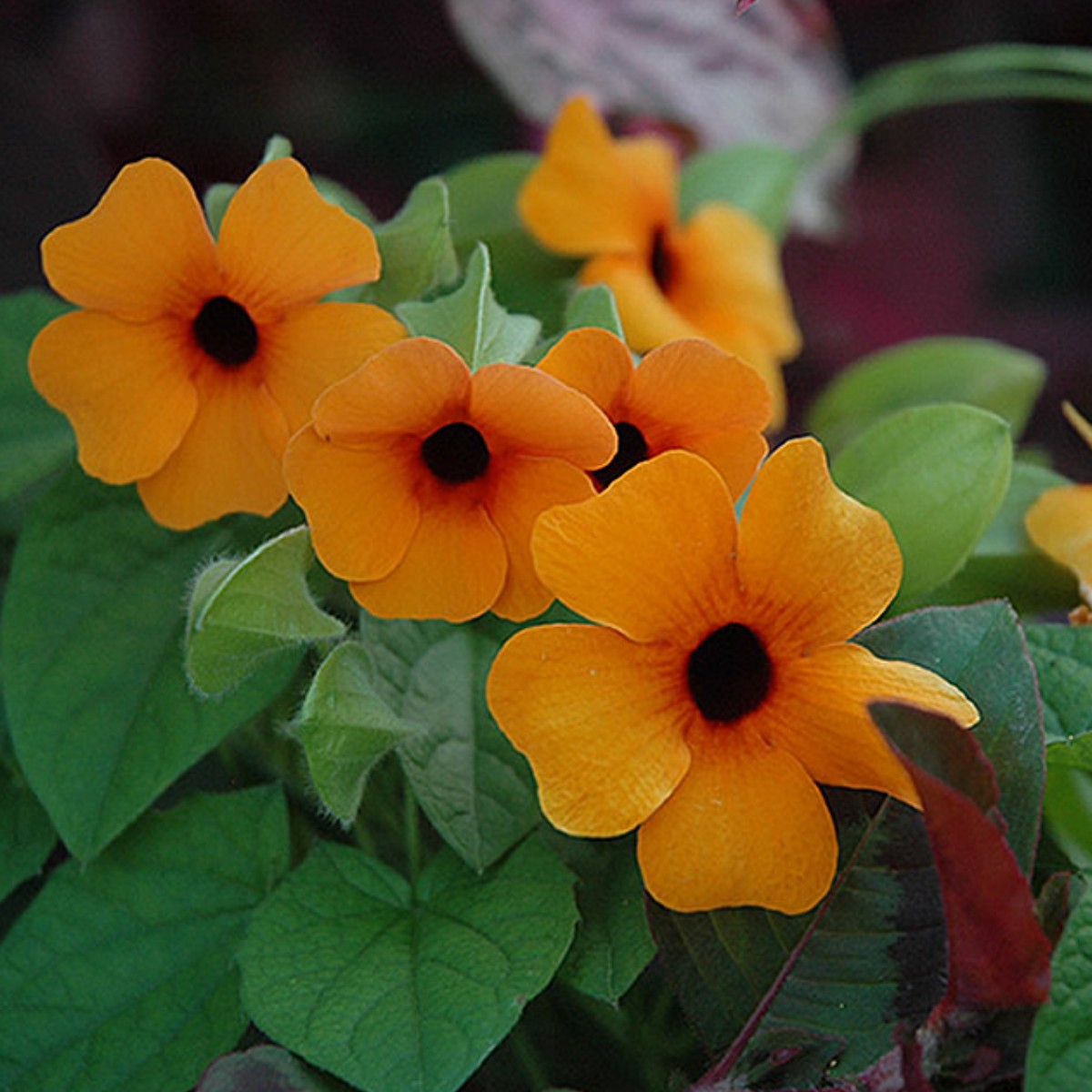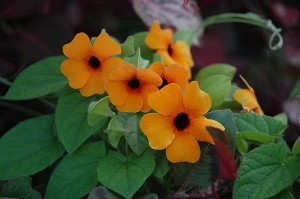Family: Acanthaceae
Synonymous: Endomelas alata
Thunbergia alata var. fryeri
Thunbergia alata var. albiflora
Thunbergia alata var. aurantiaca
Thunbergia alata var. bakeri
Thunbergia alata var. vixalata
Thunbergia alata var. lutea
Thunbergia alata var. reticulata
Thunbergia alata subvar. doddsii
Thunbergia alata var. sulphurea
Thunbergia alata var. albiflora
Thunbergia alata var. alba
Thunbergia alata var. retinervia
Thunbergia albiflora
Thunbergia aurantiaca
Thunbergia backeri
Thunbergia doddsii
Thunbergia fryeri
Thunbergia manganjensis
Thunbergia reticulata
Distribution and habitat: Thunbergia alata is a herbaceous perennial climbing plant species in the Acanthaceae family. It is native to Eastern Africa and has been naturalised in other parts of the world. It is found in Cerrado vegetation of Brazil and Hawaii, along with eastern Australia and the southern USA in the states of Texas and Florida.
Description: Thunbergia alata is a fast growing twining plant with attractive flowers. Its leaves are tooth-edged, triangular to arrow-shaped, up to 8cm (3 inch) long and wide, borne on slender stalks along the twining stems. Flowers are about 5cm (2 inch) wide and are produced on short stalks from the leaf axils, consist of a 2cm (0.8 inch) long tube flaring out into five petal-like lobes. Petal-lobe colour varies, but in all forms there is a central deep chocolate 'eye' - the centry point to the tube for insects; the tube itself is sark purple and each flower is backed with a pair of 1-2cm (0.4-0.8 inch) long, pale green bracts. The most common lobes colours are orange-yellow, bright yellow or white. The flowering period normally last from late spring to late autumn.
Proper care: Thunbergia alata is the only species of this genus sometimes grown as an indoor plant. Although actually a perennial, it is usually treated as a temporary indoor plant to be enjoyed during the and then discarded.
Thunbergia alata plants usually twine around three of four thin sticks pushed into the edge of the pot but they will also climb up a string fixed to the side of a window. In either case, they are probably best cut down and discarded when flowering strops.
Be sure to remove faded flowers by nipping them out with the fingertips. If this is not done regularly, flowering will be needlessly brief.
Light: Thunbergia alata must have bright light with two to three hours a day of direct sunlight to flower properly.
Temperature: These Thunbergia alata plants will do well in any normal room temperature during their stay in the home. Nevertheless, they can tolerate much cooler conditions - down to 10C (50F).
Watering: Water young Thunbergia alata plants moderately, enough to make the potting mixture moist at each watering, but allowing the top centimetre (0.4 inch) or so of the potting mixture to dry out before watering again. As these swift-growing plants get bigger and begin to flower, they need more water. Throughout the flowering period water them plentifully to keep the potting mixture thoroughly moist.
Feeding: Give standard liquid fertiliser to flowering Thunbergia alata every two weeks throughout year.
Potting and repotting: Use a soil based potting mixture. Young Thunbergia alata plants should be moved on when they grow too big for their original pots. When roots begin to appear through the drainage hole in the bottom of a pot, move the plant into a pot two sizes larger. Probable maximum pot size needed is 15cm (6 inch).
Gardening: Since Thunbergia alata vines are perennial, they can be potted up and bring them indoors for the winter. They can be cut back to a more manageable size, when prepared to be indoor overwintered.
Position: Thunbergia alata will prefer full sun. In hot climates, growing the plants in partial afternoon shade is recommended.
Soil: Thunbergia alata likes a fairly neural soil pH, of around 6.5 and a soil rich in organic matter. When setting out plants, work about 5cm (2 inch) of compost into the soil, if it is not sufficiently rich to start with.
Irrigation: Thunbergia alata do not like sitting in wet soil, they also do not like being hot and dry. Mulching around the base of the plants will keep the roots cool and moist, without fear of rotting.
Fertiliser: Thunbergia alata is quick growing and repeat blooms throughout the summer. That means they will get hungry and will need a light feeding every 4-6 weeks, with a complete fertiliser, to keep it growing strong.
Propagation: Seed can be grown indoor without too much difficulty if it is sown early in spring. These seeds should be planted in a single 8cm (3 inch) pot containing a moistened soil based potting mixture.
They will usually germinate in three to five weeks if kept in a warm room in a position where they get bright filtered light and are watered enough to make the mixture moist, but with the top centimetre (0.4 inch) or so of the mixture allowed to dry out between waterings. The new plant will grow quickly and may be transferred to individual 8cm (3 inch) pots and treated as mature Thunbergia alata when they are 15cm (6 inch) high.
Problems: Thunbergia alata is not prone to many problems, particularly if the vines are kept healthy and have plenty of sun, water and air circulation.
Whiteflies and spider mites can be potential problems, especially during hot weather and if brought indoors with dry heat.
Treatment: Keep a keen eye, to catch and treat any out breaks quickly with insecticidal soap.
Buying tips: Buy Thunbergia alata young plants only a few weeks old in the spring.
Companion plants: With their quick growth habit and sprawling nature,Thunbergia alata vines can overtake nearby plants and are often grown as solo performers. However a nice option is to mix theThunbergia alata vines with another vine that will intertwine with them. Species of flowering plants in the family Convolvulaceae (Morning Glories) are often used for this purpose, particularly the purple varieties, which make a nice color combo. Purple Hyacinth bean is another good choice.
They look beautiful near shorter purple flowers, like salvia and veronica, too. On the flip side, can be played up their flair with hotter colors, like brilliant red zinnias or canna, for a more tropical look.
Uses and display: Thunbergia alata are grown as ornamental plants in gardens and in hanging baskets. These vines grow quickly, once the temperature warms up. They will tangle themselves around the nearest support or spill over edges. They are perfect for hanging containers, but flow just as easily over walls and raised beds.
A lattice or link fence makes a good choice for coaxing and weaving this vine into a living wall, but these plants will clamber over just about anything, from the mail box to an old tree stump.
SUMMARY:
CHARACTERISTICS:
Foliage green
Features flowers
Shape climbing and trailing
Height: 1.8-2.4m (68 feet)
PROPER CARE:
Watering in active growth period plentifully
Light bright
Temperature in active growth period min 10C max 24C (50-75F)
Humidity low
Hardiness zone: 9a-10b
